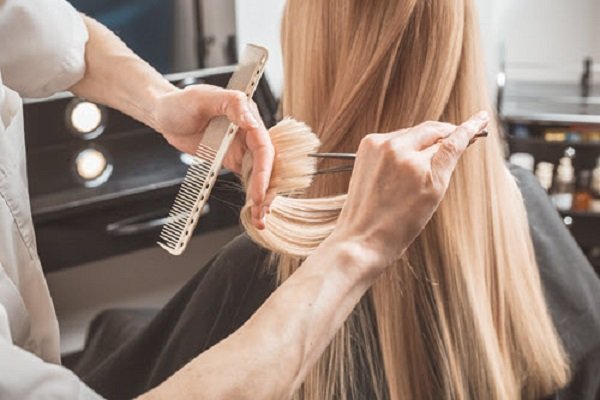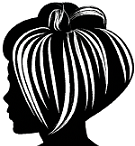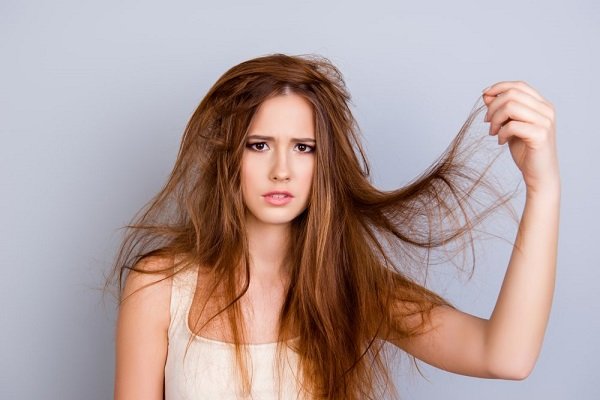In this article, we will discuss the difference between dry hair and dehydrated hair. It may seem similar, but there are important differences that determine the condition of the hair and affect its care.
We’ll explore the causes and signs of each condition, as well as tips for improving hair health and keeping it moisturized. Learn more about this important topic of caring for your hair.
Dehydrated Hair meaning
Dehydrated hair means hair that lacks natural moisture, and can be caused by many factors such as external factors such as dry weather, wind, and sun, and internal factors such as unbalanced nutrition and excessive heat exposure.
It can be easily identified by noting the following: Hair care routine for hair growth The strands are dull and tangled, and can become brittle and damaged faster than natural hair.
Dehydrated hair can be a real challenge to deal with. If you struggle with dry, dull, and brittle hair, it’s time to explore effective treatments that can restore moisture and vitality to your locks.
In this article, we will provide valuable advice and recommend top-quality products to revitalize your hair.
The causes of Dehydrated hair
Understanding the root causes of hair dehydration can help you take better care of your hair and prevent further damage. Here are some common factors that contribute to hair dehydration:
1. Overuse of thermal styling tools
Frequent use of heat tools, such as flat irons and curling irons, can strip your hair of moisture, leaving it dry and lifeless.
2. Environmental factors
Exposure to harsh environmental conditions, such as sun, wind, and pollution, can cause hair to lose its natural moisture, leading to dehydration.
3. Chemical treatments
Chemical treatments such as dyeing, perming, Unlimited Tips for color hair and relaxing can weaken the hair structure, causing dryness and dehydration.
4. Styling products
Some styling products, such as gels, mousses, and hairsprays, contain alcohol and other drying agents that contribute to hair dehydration over time.
Dry or dehydrated hair: what are the differences?

Dry hair is hair that lacks nutrients. It can be identified by its forks, brittle, dull appearance, and lack of shine. All of these problems are generally caused by repeated mechanical and chemical attacks, discoloration, or stains.
Rarely, this phenomenon can occur without the hair being mistreated. By pushing, the panels are more likely to rub against the clothing and pillowcase or simply become fixed, promoting their breakdown.
Dehydrated hair needs water. Just like dry hair, dehydrated hair is rough and dull. But certain details make the difference with dry hair: hair that lacks moisture curls a lot, has a straw effect, breaks easily, and forms a lot of knots when washed. The causes for this are usually a lack of water in the body, excessive sun exposure, or mechanical problems. Blow-drying, for example at too high a temperature or done too often, can help strip the hair of moisture. Result: The hair is porous and frizzy.
Tips to treat dehydrated hair
Now that we have talked about the causes, let’s delve into effective tips to treat and prevent hair dehydration:
1. Choose a hydrating shampoo and conditioner
Look for shampoos and conditioners specifically formulated for dry, damaged hair. These products often contain hydrating ingredients, such as argan oil, shea butter, or coconut oil, to replenish lost moisture.
2. Limit heat styling
Reduce the frequency of using heat styling tools and always apply a heat protection spray before blow-drying, curling, or straightening your hair.
3. Trim your hair regularly

By trimming it regularly, you will eliminate split ends and prevent further damage that can worsen hair dehydration.
4. Protect your hair
When facing adverse weather conditions, put on a hat or wear a scarf to protect your hair from direct exposure to the sun, wind, or rain.
The Best Hair Care Products for Dry, Damaged Hair
5. Deep condition your hair weekly
Integrate a deep conditioning treatment into your hair care routine. Apply a nutrient-rich hair mask or oil treatment once a week to restore moisture and nourish your hair.
6. Minimize chemical treatments
Avoid overusing chemical treatments on your hair, as they can further weaken and dehydrate your strands. Whenever possible, opt for more natural and gentle alternatives.
How to recognize dry hair that needs hydration

Straw-looking hair, dull and dull hair, split or thinner ends, hair that is increasingly difficult to untangle after a shower… These are all signs that your hair is dry and lacks hydration.
- Dry hair often looks dull and brittle, lacks flexibility, shine, and softness, is porous and rough to the touch, and is prone to frizz.
- Dry hair undergoes several stages of alteration, ranging from dryness to total hair deterioration. As with all hair problems, the condition usually originates in the scalp. The scalp does not produce enough sebum through the sebaceous glands. Thus, the hair weakens on the surface (the hair cuticles are damaged) and then gradually becomes more fragile on the inside (the keratin, the hair core cell, is affected).
- It can also result from aggressive (and repeated) actions on the lengths: coloring, excessive drying, straightening, or friction (hair elastics or motorcycle helmets, for example).
Whatever the case, we must act quickly to stop the vicious cycle of hair dryness and lack of nutrition of hair fiber.
Hair Hydration Tips for Dry and Dehydrated Hair

You can check out the following moisturizing tips for dry and dehydrated hair:
1. Use shampoos specifically for dry hair.
Do not use hair products with alcohol as these will dry out the hair.
2. Use a moisturizing shampoo and conditioner.
This protects the hair’s natural oils by acting as the cuticle to protect the hair.
3. Massage your scalp with jojoba and coconut oil to moisturize your hair.
4. You can meet the moisture needs of your extremely dry and damaged hair by using Coconut oil, jojoba, and olive oil.
5. Easy care mask for dry hair consists of only 3 ingredients:
Argan oil, olive oil, and vitamin E capsule.
These tips can increase your hair’s moisture levels and make it look healthier.
However, keep in mind that since every hair type is different, not all of these suggestions may work for everyone. You may consider trying different methods to find the one that best suits your hair.
Tips for Bringing Dehydrated Hair Back to Life
Here are some tips to help bring dehydrated hair back to life:
1. Understand the difference between dry and dehydrated hair:
Dehydrated hair happens when there is a lack of water, while dry hair usually stems from excessive exposure to chemicals, hair dyes, and heat¹.
2. Identify if your hair is dehydrated:
Dehydrated hair typically looks dull, feels rough, is tough to style, is extra oily, lacks volume, and split ends are much more noticeable¹.
3. Use a hydrating hair care system
Boost your strands with hydration by using a moisturizing hair care system.
4. Add reparative products to your routine:
Adding a hydrating serum to your hair care routine can help.
5. Protect your hair:
Avoid overexposure to the elements and weather, the sun’s UV rays, and pollution. Also, be mindful of the types of hair products you use and the frequency of chemical services you have done on your hair.
6. Minimize heat usage:
If you must use a blow-dryer, let your locks air-dry as much as possible, and then dry them on a low-heat setting.
Remember, it’s important to drink plenty of water and maintain a healthy diet, as these factors also contribute to the health of your hair. If these tips don’t work, it might be best to consult with a professional hairstylist or a trichologist.
FAQs
What should we not do after permanent hair straightening?
Wash your hair for at least 2-3 days to allow the treatment to set.
Tying your hair tightly or using hairbands for the first few days.
Exposing your hair to moisture, such as rain or excessive sweating.
Using harsh hair products with sulfates or chemicals that can strip the treatment.
Frequent heat styling or using high heat settings.
Can I wash my hair after 2 days of permanent straightening?
A4: It’s generally recommended to wait at least 2-3 days before washing your hair after permanent straightening to allow the treatment to set. Washing too soon can potentially affect the results. Follow the instructions provided by your hairstylist for the specific waiting period recommended for your treatment.
What Is the Best Way to Maintain Long Hair?
The best way to maintain long hair is through a combination of regular trims, gentle washing, proper hydration, and protection from heat and environmental factors.
conclusion
In short, it can be said that the difference between dry hair and dehydrated hair lies in the causes of their occurrence and their distinctive signs. Dry hair needs extra moisture to nourish it and improve its appearance, while dehydrated hair needs its natural moisture restored.
It is important to know your hair type specifically to determine the best ways to care for it and maintain its health. Therefore, you should choose the right products and follow the right habits to care for your hair.

